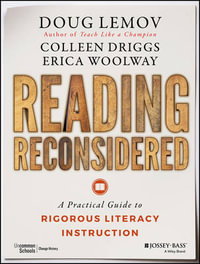DVD Contents ix
About the Authors xvii
About Uncommon Schools xix
Acknowledgments xxi
Introduction 1
PART 1 The Core of the Core 11
1 Text Selection 13
Module 1.1: The Decline of the Canon 18
Module 1.2: Text Attributes and Leveling Systems 23
Module 1.3: The Five Plagues of the Developing Reader 29
Module 1.4: Book Choice 45
Module 1.5: Managing Selection 52
2 Close Reading 57
Module 2.1: Layered Reading 63
Module 2.2: Establish Meaning via Text-Dependent Questions 71
Module 2.3: Close Reading to Analyze Meaning 83
Module 2.4: Processing Ideas and Insights in Writing, and the Power of Clear Focus 97
Module 2.5: Close Reading Bursts 102
3 Reading Nonfiction, and the Challenge of Background Knowledge 113
Module 3.1: The Key Challenge: Background Knowledge 117
Module 3.2: Absorption Rate 120
Module 3.3: Embedding Texts to Increase Absorption Rate and Build Background Knowledge 123
Module 3.4: OtherWays to Build Background Knowledge 137
Module 3.5: Some Unique Challenges of Nonfiction 143
4 Writing for Reading 155
Module 4.1: Reading Class Cycles 161
Module 4.2:Writing Is Revising 178
Module 4.3: Art of the Sentence 186
Module 4.4: Building Stamina 195
Module 4.5: Monitoring and Assessment via the Stack Audit 200
PART 2 The Fundamentals 205
5 Approaches to Reading: Reading More, Reading Better 207
Module 5.1: Approaches to Reading 211
Module 5.2: Accountable Independent Reading (AIR) 216
Module 5.3: Control the Game 225
Module 5.4: Read-Aloud 239
6 Vocabulary Instruction: Breadth and Depth 249
Module 6.1: Explicit and Implicit Vocabulary Instruction Compared 253
Module 6.2: Explicit Vocabulary Instruction:The Daily Word Rollout to Achieve Deep Word Knowledge 256
Module 6.3: Implicit Instruction: Building Vocabulary During Reading 270
Module 6.4: Maintenance and Extension 281
7 Reading Systems 287
Module 7.1: Interactive Reading: An Overview 290
Module 7.2: Phases of Implementation: Rollout, Modeling, Prompting, Autonomy 293
Module 7.3: Interactive Reading System: How to Mark Up a Text (and What to Mark) 299
Module 7.4: Discussion Systems: Laying the Groundwork for Habits of Discussion 307
Module 7.5: Discussion Systems: Beyond the Groundwork 314
8 Toward Intellectual Autonomy 323
Module 8.1: Frameworks for Interpretation 327
Module 8.2: Technical Vocabulary 338
Module 8.3: Phases of Development 342
Module 8.4: Autonomous Writing Structures 352
Module 8.5: Autonomous Discussion Structures 355
Appendix: Useful Tools 365
Index 387
How to Access the Online Contents 411
How to Use the DVD 413
More Ways to Engage and Learn with Teach Like a Champion 415





